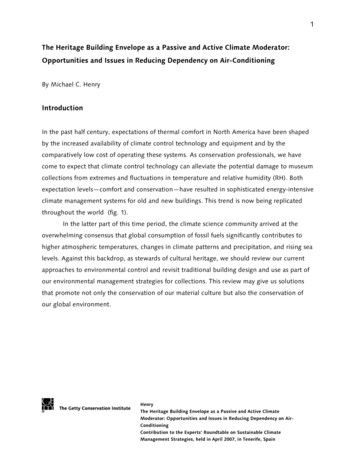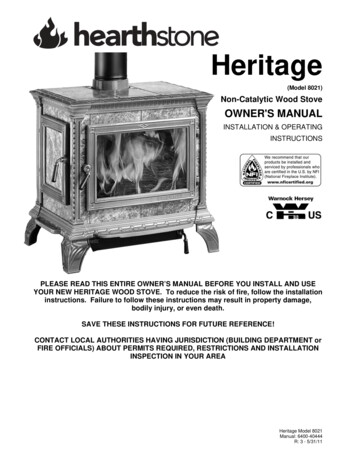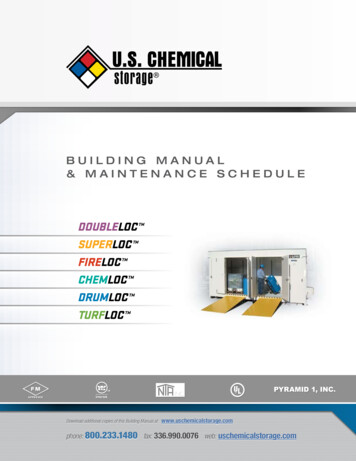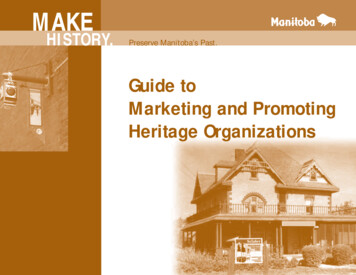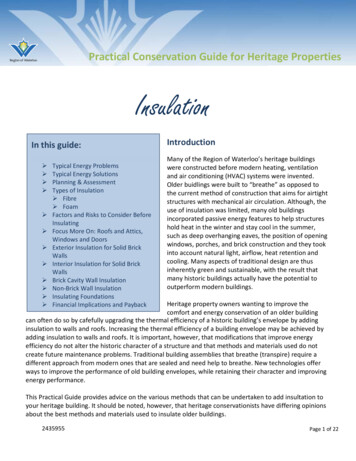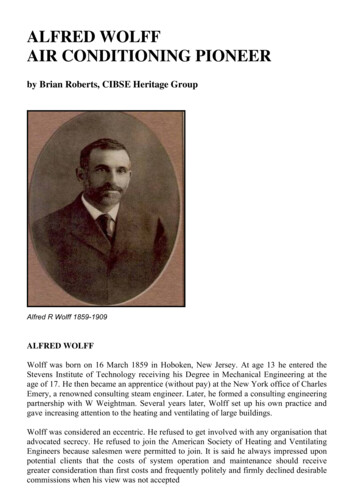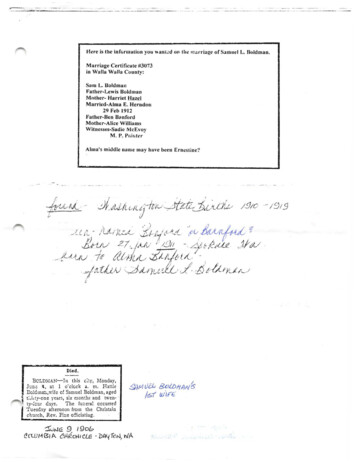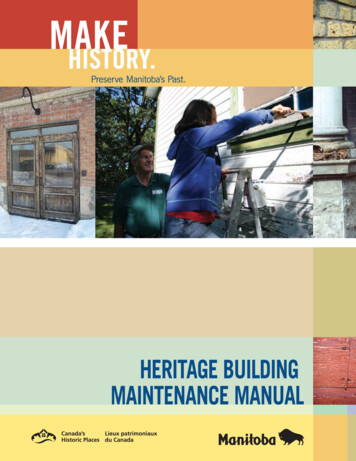
Transcription
HERITAGE BUILDINGMAINTENANCE MANUAL
This manual contains useful information on restoring and preserving heritage buildings, but itis intended as a general guide only. The Provincial Government has taken all reasonable stepsto ensure the accuracy of the information in this publication. However, it recommends thatbuilding owners consult with specialists, such as contractors, builders, plumbers, heating andair professionals and electricians, when doing any renovations, repairs or construction on theirproperties. The province does not assume responsibility for any loss or damage resulting fromreliance on the information in this manual.
CONTENTSINTRODUCTION3PART 1.WHAT IS MAINTENANCE?5PART 2.PRE-PLANNING7PART 3.WHERE DO I START?9PART 4.MAINTAINING THE PARTS154.1Building Envelope154.2Foundations164.3Exterior Walls184.4Roof214.5Gutters and Downspouts244.6Site Drainage264.7Windows and Doors284.8Features and Details304.9Energy Efficiency33WORKSHEETS355.1Inspection Checklist365.2Maintenance Checklist465.3Maintenance Record545.4Project Worksheet555.5Budget565.6Frequently Called Numbers59REFERENCES616.1Toolkit Checklist636.2The Standards and Guidelines for the Conservation of Historic Places in Canada656.3Hiring a Professional696.4Troubleshooting726.5Resource List75PART 5.PART 6.The Historic Resources Branch gratefully acknowledges the support of the Government of Canada through the Historic PlacesInitiative, a federal, provincial, territorial partnership.HERITAGE BUILDING MAINTENANCE MANUAL - www.manitoba.ca/heritage1
2
INTRODUCTIONNo building is maintenance-free, so every structure, heritage or new, requires care to limitdeterioration.Exposure to the elements causes all building materials to wear down eventually. Periodicinspections can help you find problems early and, along with regular maintenance, will extend thelife of your building. They will also help you avoid the need for potentially expensive and disruptiverepair work, which may damage your building’s heritage value.It’s a good idea to set up a building maintenance schedule to remind you of any inspections or workthat needs to be done. It will also help you prioritize maintenance, preventing avoidable, costly,future repairs.A Maintenance Manual as a GuideOne maintenance manual does NOT fit all because every building is unique. This manual providesgeneral guidelines on topics common to most buildings.Starting with the roof and moving through various major building components, the manual focuseson typical issues of deterioration. There are worksheets included for your convenience. They willhelp you do regular inspections of your building to look for deterioration at its earliest stage. Themanual will also help you organize the maintenance and repair jobs that must be done regularly.This manual will help you: plan your building’s maintenance to conserve your heritage building maintain the basic parts of your building solve common problems of typical building systemsPlease note that this manual provides a general overview of building maintenance and does notreplace any operations or maintenance manuals published by the manufacturers of specificbuilding materials. Ensure any manuals or other publications you consult are appropriate to heritagebuildings in our unique climate. You may find that published advice on building topics such asinsulation or moisture accumulation may not be applicable in Manitoba.Architectural materials and construction methods used in other areas of North America may besimilar, yet significantly different, from those used in Manitoba. Relying on out-of-province manualscan lead to inappropriate maintenance practices.The Heritage Buildings Unit team invites your maintenance-related questions, comments orsuggestions. Please contact:Heritage Buildings UnitHistoric Resources BranchManitoba Culture, Heritage, Tourism and SportMain Floor, 213 Notre Dame Ave.Winnipeg, MBR3B 1N3INTRODUCTIONPhone: 1-204-945-2118Toll free: 1-800-282-8069, ext. 2118Fax: 1-204-948-2384E-mail: hrb@gov.mb.ca3
4
PART 1:WHAT IS MAINTENANCE?
PART 1. WHAT IS MAINTENANCE?All building materials decay eventually due to sunlight, rain and wind, and therefore theyrequire continued attention if a building’s condition is to be maintained. Modest spending onregular maintenance can reduce the need for costly repairs, protect the fabric of your buildingand save you money in the longer term.As defined by the Standards and Guidelines for the Conservation of Historic Places in Canada(2004), MAINTENANCE is:Routine, cyclical, non-destructive actions necessary to slow the deterioration of a historic place. Itentails periodic inspection; routine, cyclical, non-destructive cleaning; minor repair and refinishingoperations; replacement of damaged or deteriorated materials that are impractical to save.Maintenance can be broken down into three categories: Corrective Maintenance: work necessary to bring a building to an acceptable level (oftenrecommended by a conservation plan), such as treatment for moisture. Emergency Maintenance: work that must be done immediately for health, safety or securityreasons or that may result in the rapid deterioration of the structure or fabric if not done,such as roof repairs after a storm or repairing broken glass. Planned Maintenance: work to prevent problems which can happen predictably within thelife of a building, such as cleaning gutters or painting.The best type of protection is to do regular and routine maintenance, to prevent extensive andexpensive repairs. Maintenance planning must be consistent with your needs and respectfulof your financial means, while ensuring that your building is evaluated annually. A plan that istoo complicated or onerous will simply not get completed.Much of the work we are encouraging in this manual is planned maintenance. In the initialphases of developing a maintenance plan, there may be corrective or emergency maintenancethat must be done before a routine, cyclical approach can be adopted.The Importance of MaintenanceGiven the importance of material integrity in a heritage building, it is obvious that, wheneverthe option presents itself, preserving an original building element is preferred to a replica. Toensure that a building maintains its integrity, it is critical that maintenance takes a leading rolein a building owner’s plans and activities.By maintaining heritage sites -- repairing, cleaning, or correcting defects -- we are not onlypreventing deterioration of precious original materials, we are also ensuring that possible hazardsare avoided. The purpose of maintenance is to ensure longevity, reduce costs and improve value.So what is the dividing line between maintenance and repair? Basically, if things are let go too long,you can almost be assured of more serious problems. Occasionally, materials such as roof shingles,will require replacement. However, the implementation of a diligent maintenance program will limitthe need to repair or replace on a large scale and extend the life of those original materials.PART 1. WHAT IS MAINTENANCE?5
6
PART 2:PRE-PLANNING
PART 2. PRE-PLANNINGThere are several practical questions a building owner should ask before undertakingmaintenance work. Answering these questions will help establish the scope of work and willallow a building owner to identify the various resources that will make the work a success.Can you undertake the work yourself? To answer this question you need to know exactly what the job will entail. Consider any specialskills required such as turning wood on a lathe or the proper strike when repointing masonry. In your day-to-day activities involving family, work and other interests, do you have the timeyou will need to commit to the project you are planning? Should you hire someone else todo the work? Is it physically possible for you to carry out the work without the committed assistance ofothers? Can you rely on the assistance of others for the duration of the project? If you are unable to carry out all the work yourself, you will need to consider where to findthe appropriate trades required for the job.Can you undertake the work safely? Are you aware of all the necessary precautions that must be observed with all aspects ofthe job? For example, it’s not unusual for people to be unaware of dangerous compoundsthat form when mixing chemicals. And that materials such as asbestos siding and ureaformaldehyde foam insulation (UFI) require specific protective equipment and disposal. Safety harnesses, headgear, footwear and breathing equipment are just a few of the piecesof items required for building-related work. Are these items available to you and do youknow how and when to use them? The safety of occupants, visitors to the site and the general community must be consideredwhen any project is planned. Be aware of Health and Safety regulations. Even as avolunteer organization, you will be held responsible in the case of an accident. Propersignage and fencing of the worksite are just a few considerations for the safety of others.Will the planned tasks affect other parts of the site? Often, a maintenance project can affect other parts of a building. For example, applyinga waterproof coating to prevent moisture penetration could damage the masonry. If thesebyproducts of your work are not anticipated, then you may not budget the right amount ofresources to ensure a satisfactory outcome. If you are undertaking a project that requires the placement of heavy equipment outsidethe building, consider the damage the equipment may make to your grounds, fencing orneighbouring properties. Whenever you are planning a project, think about how your work activities, or the activitiesof others on the project, may affect areas that are not within the scope of the project.PART 2. PRE-PLANNING7
Is your budget realistic? The potential for unforeseen events or delays during the course of a renovation project arealways present and can greatly affect the final cost of the work. Unwelcome surprises in thebuilding itself (especially in walls, where shoddy work may have been masked, or where anunusual procedure has been employed) can also escalate costs. Thoroughly investigating the area to be worked on, checking for hidden or unused buildingelements within walls (such as radiant heat lines in a building converted to forced air) willreduce the element of surprise in a project, in turn making cost estimates more accurate. Plan for cost overruns. Apply a contingency element in your budget that, if necessary, canbe made available to bring your project to completion. After factoring in the potential for surprises, is the project still within your budget?Do you require heritage and/ or building permits? It is important to realize that once a building has been designated under the HeritageResources Act, a heritage permit must be granted by the municipal and/or provincialgovernment before any major physical alterations take place. However, most of whatwould be classified as maintenance should not need a heritage permit, as it should notdramatically interfere with the physical integrity of the building. One of the primary intents of building permits is to ensure that a project is conducted ina safe manner, using appropriate standards and materials, thereby reducing the risk ofhazardous environments for occupants, now and in the future. Be sure to ask staff at the Historic Resources Branch and/or your municipal office to findout what permits you require.8PART 2. PRE-PLANNING
PART 3:WHERE DO I START?
PART 3. WHERE DO I START?This is a familiar question to anyone who has faced the sheer volume of work to be doneand tried to prioritize the needs of a conservation project. This next section identifies fivesteps of the conservation process. These steps will apply to any conservation project, not justmaintenance tasks, and may be useful for you to review whenever you are considering work toyour historic place.STEP 1: Identify the heritage value and character-defining elementsBefore planning any maintenance to a historic place, it isessential to understand its heritage value and to recognizeits character-defining elements, so you know what’simportant to protect.For most designated sites, a Statement of Significance(a brief report on what makes the site important,used on the Canadian Register of Historic Places,www.historicplaces.ca) will provide details on why aplace is important and what physical elements are mostManitoba’s Statement ofSignificance Certificateimportant. Pay particular attention to the character-definingelements. These building features will give you clearerdirection on the most significant physical aspects of your building, and help you prioritizeyour conservation efforts.If your property is not designated, you can conduct your own physical survey so you have list ofbuilding features that will need to be considered in your conservation planning. Start with the building’s overall features such as the form, scale and massing. Look at the immediate site, gardens and landscaping that may directly affect the building. Look more closely at the exterior and record the materials used. Finally, it is important to look inside your building and record the interior features, finishesand notable details.STEP 2: Review the Standards and GuidelinesThe Standards and Guidelines for the Conservation of Historic Places in Canada is thefirst-ever pan-Canadian benchmark for heritage conservation practice in this country. It offersresults-oriented guidance for sound decision-making when planning for, intervening in and usinghistoric places. These guidelines are not intended to replace the role of conservation specialistsor to provide detailed technical instructions, but can help you through the process of makingdecisions about your property.The Standards are the fundamental principles of conservation applicable to all types of heritageresources, including archaeological sites, l
This manual contains useful information on restoring and preserving heritage buildings, but it is intended as a general guide only. The Provincial Government has taken all reasonable steps to ensure the accuracy of the information in this publication. However, it recommends that building owners consult with specialists, such as contractors, builders, plumbers, heating and air professionals and .
